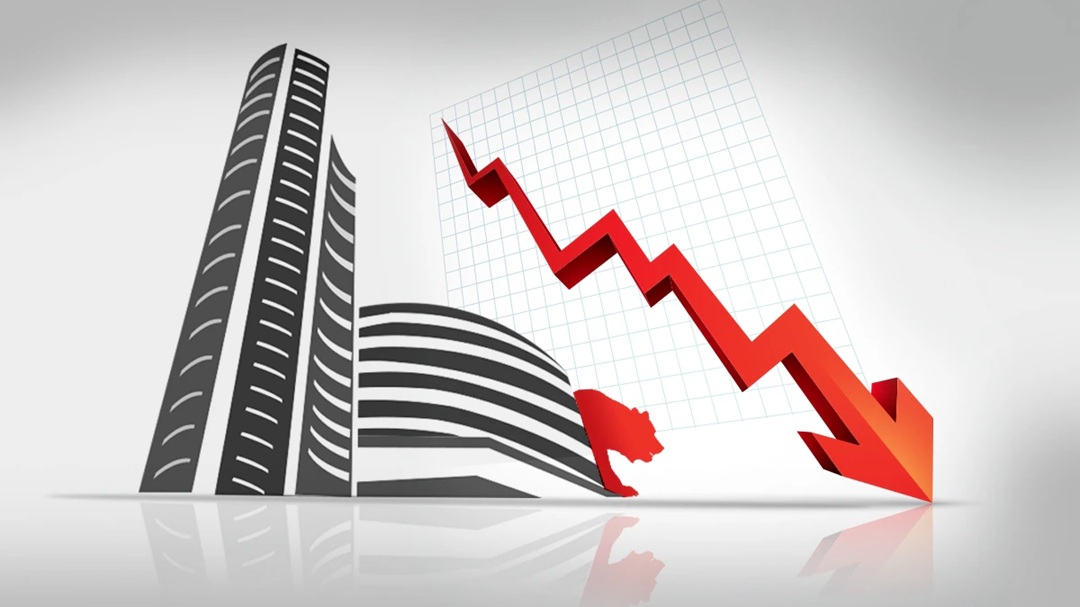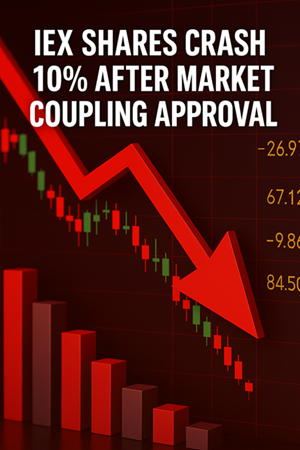IEX shares fall 10% after CERC approves market coupling implementation. Over 4.1 crore sell orders pending amid regulatory uncertainty and price discovery risks.

The Indian Energy Exchange (IEX) shares declined by nearly 10% on Thursday, July 24, following the Central Electricity Regulatory Commission (CERC)‘s approval of market coupling norms. The move is seen as a serious threat to IEX’s dominance in the electricity spot market, with over 4.1 crore sell orders pending at the lower circuit on NSE.
⚡ Why Did IEX Shares Crash Today?
The sharp fall in IEX stock comes after CERC approves of market coupling—a system that aggregates buy and sell orders across all electricity exchanges to discover a uniform clearing price.
Although aimed at improving market efficiency and price transparency, the regulation has raised concerns over IEX’s competitive advantage, which lies in being the preferred platform for price discovery in the spot electricity market.
🔍 What Is Market Coupling?
Market Coupling is an energy trading model where all buy and sell orders from various exchanges are merged, and a single clearing price is determined for the entire market.
Under CERC’s plan:
- Phase 1: Day-Ahead Market (DAM) to be coupled by January 2026
- Market Coupling Operators (MCOs) will run exchanges on a round-robin basis
- Grid India will serve as a backup operator and develop Term-Ahead Market software
- Real-Time Market (RTM) coupling to be considered after DAM implementation
👉 This approach removes the platform-specific advantage and introduces uniformity in pricing, diluting IEX’s edge.
📉 Impact on IEX and Investor Sentiment
The market coupling decision contradicts the findings submitted earlier by Grid India, which advised caution. Now, investors fear this could result in:
- Loss of monopoly: IEX currently holds 85% market share in the spot electricity trading space.
- Reduced transaction charges: Competition will likely bring down transaction fees, hurting revenues.
- Shift in volume: Trading could migrate to other competitive platforms.
🔺 Broker Reaction:
Brokerage Bernstein retained a Market-Perform rating but slashed IEX’s price target from ₹160 to ₹122, implying a 35% downside. The firm commented:
“Coupling is now a certainty from January 2026, and the regulatory overhang makes IEX an unattractive long-term hold for institutions.”
💡 Key Market Data (As of July 24, 2025)
| Metric | Value |
|---|---|
| Opening Price | ₹169.10 |
| Intraday Fall | -10% |
| Pending Sell Orders | 4.1 crore shares |
| Market Status | In F&O Ban |
| 1-Month Performance | Flat |
| Analyst Rating | Market Perform (Hold) |
| Target Price (Bernstein) | ₹122 (vs ₹160 earlier) |
🏛️ CERC’s Rationale Behind Market Coupling
According to CERC, the Indian electricity market is undergoing a major transformation driven by the renewable energy push and the need for:
- Better liquidity
- Stronger price discovery mechanisms
- Efficient market-based allocation of energy
With India aiming to reach 500 GW of renewable capacity by 2030, market coupling is seen as essential to integrate renewable energy sources and streamline trading across platforms.
“The current market has only 7% liquidity, multiple segments, and aggressive bidding—market coupling addresses these challenges,” the commission noted.
📌 Internal Analysis: What’s Next for IEX?
While IEX has maintained dominance for years, the January 2026 deadline for implementation of coupling could mark a turning point.
- Volume migration is likely as price differentiation vanishes.
- Revenue pressure due to lower transaction fees.
- Uncertain outlook until more regulatory clarity emerges.( IEX Shares)
👉 For an in-depth look at IEX’s earlier performance and business model, you can read our analysis on India’s Leading Energy Exchanges (🔗 Internal link).
According to a detailed report by the Economic Times, the CERC’s approval of market coupling is expected to significantly impact the trading dynamics on power exchanges. Read full article
🧠 Expert Insights on Market Coupling in India
- Vibhuti Garg, South Asia Director, IEEFA:
- “Market coupling, while good for long-term transparency, challenges the market leader’s dominance in the short run.”
- Anil Sharma, Energy Analyst:
- “This is a move towards a level playing field. It’s disruptive but necessary in a maturing market.”
❓ Frequently Asked Questions (FAQs)
1. Why did IEX Shares fall 10% today?
Because the CERC approved market coupling regulations, which threaten IEX’s price discovery advantage and dominance.
2. What is Market Coupling in the electricity sector?
Market Coupling is a model where a single price is discovered by merging orders from all electricity exchanges, creating a uniform and efficient market.
3. When will Market Coupling be implemented in India?
CERC plans to implement Phase 1 (Day-Ahead Market coupling) by January 2026.
4. Will IEX Shares continue to be profitable after coupling?
Analysts expect increased pressure on IEX’s margins and transaction volumes, but long-term performance depends on adaptation and diversification.
5. Is IEX Shares in F&O ban?
Yes, IEX is currently in the Futures & Options (F&O) ban, preventing new derivative positions.( IEX Shares)
📣 Call to Action
Do you think market coupling will benefit the power sector or hurt investor interests?( IEX Shares)
👉 Comment your views below, share this article with fellow investors, and follow us for real-time stock market updates and expert energy market coverage.





